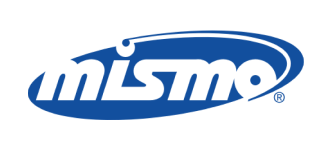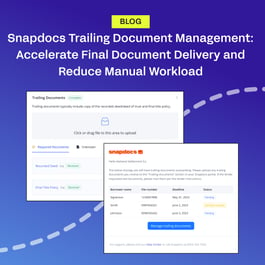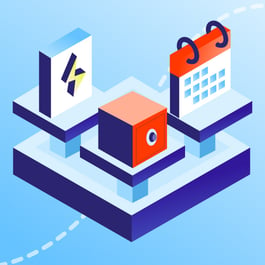An electronic promissory note (eNote) is the digital equivalent of a paper promissory note. Like a paper note, an eNote includes the terms for repayment of the loan (e.g., interest rate, loan term, loan amount). Unlike a paper note, an eNote includes language that identifies it as eNote that is electronically generated, presented, and signed (eSigned).
This article will cover several basic eNote concepts. For a deeper dive into these concepts, be sure to check out the Mechanics of eNotes white paper.
For lenders and other secondary market participants moving towards eNote adoption, it’s important to understand the technology components necessary to implement eNotes, as well as how eNotes are secured, stored, and transferred between trading partners.
There are five key technology components necessary to support eNotes: SMART Doc eNote generation, the eClosing Room, the eVault, the MERS® eRegistry, and MERS® eDelivery. Continue reading for a breakdown of each component.
eNote Component #1: SMART Doc eNote Generation
The mortgage industry, including investors such as Fannie Mae and Freddie Mac, require the use of the MISMO Standard SMART Doc eNote. The SMART Doc is an eNote format that ensures interoperability across trading partners through a common set of standards. SMART Doc eNotes have, among other requirements, specifications regarding the data that must be present, how the data must be formatted, and how the view of the eNote–what the borrower sees–compares to the underlying eNote data. These standards can be applied regardless of the technology provider used to generate the eNote.
An eNote is not simply a scanned copy of a paper promissory note. Lenders need technological capabilities to generate MISMO-compliant SMART Doc eNotes.
eNote Component #2: eClosing Room
The eClosing Room is a secure, web-based portal that allows the eNote to be accessed and viewed by borrowers, and supports the borrower’s ability to eSign the eNote. eClosing Rooms enforce several important technical safeguards throughout the eSignature process, including:
- Prompting borrowers to review and eSign all relevant documents before exiting the signing session
- Preventing the application of eSignatures to all closing documents in bulk
- Ensuring that no unauthorized alterations can be made to closing documents during the closing process
Most often, the unsigned eNote is already stored in the eVault and is presented to the borrower for eSignature via an integration between the eVault and the eClosing Room. This means the eNote is always readily available to the lender both pre and post-closing, and the lender doesn’t need to wait for the signed eNote to be transmitted back to its eVault.
eNote Component #3: eVault
eVaults plays a critical role throughout the entire lifecycle of an eNote. Once the eNote is eSigned, it is securely stored in an eVault, ensuring that the integrity of the eNote is maintained. eVaults also:
- Distinguish the single enforceable, Authoritative Copy of an eNote from other Non-Authoritative or retained copies that the eVault may store
- Transmit eNote transactions to the MERS® eRegistry–the registry used by the mortgage industry to identify parties with certain rights to eNote records
Facilitate the secure transfer of copies of eNotes between trading partners’ eVaults via MERS® eDelivery. More on MERS® eRegistry and MERS® eDelivery can be found below and in the Mechanics of eNotes white paper.
The use of an eVault for eNotes is analogous to the physical, fire-proof vaults that are used to store copies of original wet-ink signed paper notes.
eNote Component #4: MERS® eRegistry
Like any electronic file, eNotes can have multiple copies that are identical to one another. There is no “original” eNote in the same way that there is an original wet-ink signed paper note. As a result, nearly all investors require the use of the MERS® eRegistry–a registry that tracks, among other things, the party that has Control of the eNote (Controller) and the party that is maintaining the Authoritative Copy of the eNote (Location).
The Controller of an eNote has rights equivalent to that of a holder of an original wet-ink signed paper note (e.g., rights to enforce the terms of the note against the borrower, foreclose, etc.).
Location of an eNote refers to the party that is maintaining the single, enforceable Authoritative Copy of the eNote. Regardless of how many copies of an eNote might exist, this allows the industry to point to a centralized registry to identify the party that is in Control of the eNote and who maintains the Authoritative Copy of the eNote.
After the eNote is signed by all borrowers, a digital tamper-evident seal is applied to it. When an eVault registers an eNote on the MERS® eRegistry, the eNote’s tamper-evident seal value is recorded. It can then be leveraged by downstream trading partners to ensure that no alterations have been made to the copy of the eNote they received.
eNote Component #5: MERS® eDelivery
MERS® eDelivery is a secure means to transfer copies of eNotes (and other electronic records associated with eNotes) between trading partners’ eVaults. This allows eNotes and other electronic records to be transmitted without requiring direct integrations between all trading partners’ eVaults.
Most eVaults are integrated with the MERS® eRegistry and MERS® eDelivery. Together, the eVault, MERS® eRegistry, and MERS® eDelivery work hand-in-hand to effectively permit trading partners to exchange rights to eNotes. These processes take the place of the endorsement and delivery processes for wet-ink signed paper notes.



















